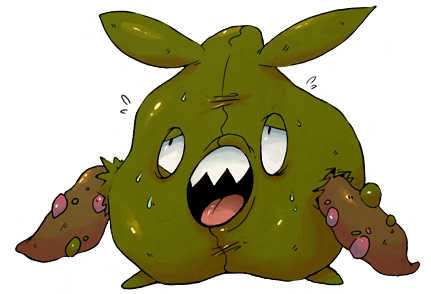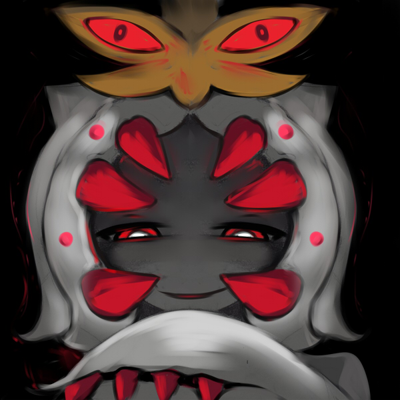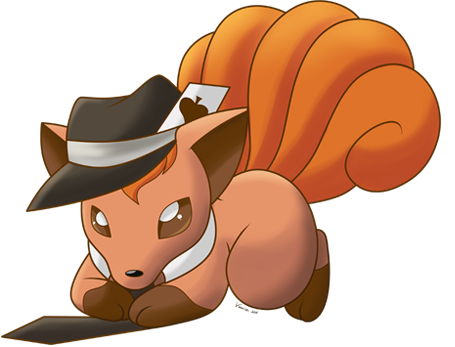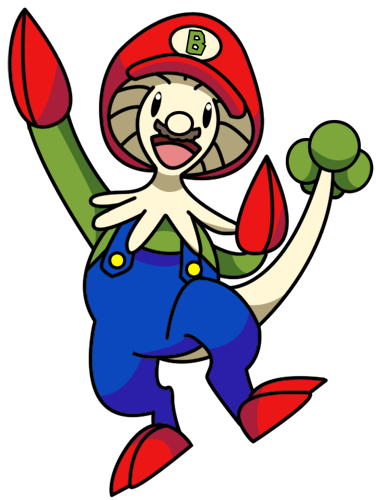Brushing Up On Your Skills: Top Tips!
| « Previous Article | Home | Next Article » |
Introduction
It's been a surprisingly short amount of time since the Tutorials thread in Smeargle's Studio has been set up, and already it has proved a hit with new-and-improving artists in the forum. But what can you, Smog reader, do to improve your art? I've consulted some of the best artists on Smogon for their own little tips and tricks:

Nastyjungle
Tutorials
- Drawing Pokemon
- Adding Texture
- Simple Drawing [India Ink]
- Painting in Photoshop
- Line Art from Sketches
One of the most important things I could say to anybody regarding art is to display an air of confidence, even if it's only just an air. Don't strut, obviously, but if you aren't proud of your art, who is? You absolutely must sell yourself to other people. The moment you tell somebody "well, it isn't very good..." or "I don't like this at all" about your own art, you cause them to lose interest in you before they've even seen anything. Make sure people know that you are proud and passionate about what you do, and they will be much more eager and receptive of what you produce. Never undersell yourself, always bolster.
Secondly, I'd say that everybody needs to learn how to accept criticism, how to interpret critiques, and how to change themselves accordingly. Art is a completely subjective entity, which means that not everybody is going to appreciate everything. Having somebody critique and judge you is not the end of the world, and it can help you grow. Often, somebody can take critique as a personal attack, or become depressed about their work. Take everything in stride, and honestly consider what some people say. Anatomy isn't perfect? Try brushing up on it. Not enough media variety? Try out something you never have before. As an artist, your main goal should be to better yourself, so when somebody suggests an area of improvement, look into it with an open mind.
Lastly, don't be afraid to mimic other people. Nobody comes out of the womb with a brush in hand ready to paint the Sistine Chapel. Art is little natural talent and almost all practice. Taking somebody else's technique and attempting to recreate it is a perfect way to grow as an artist—it lets you explore a new way of doing things, and adds techniques to your repertoire. If you don't allow yourself to be influenced by the work of others, you make for yourself a huge, unnecessary obstacle to overcome. Art can never be truly original—this is the rule. Learn from the greats to become your own person.

Yilx
1. Practice
2. Practice
3. Practice
There's nothing more important towards getting good pictures than drawing and drawing. Drawing in the right direction, of course. Drawing the same anime face 100 times over isn't going to help you improve. You need to constantly explore and delve into different styles and drawing bigger varieties of things in order to improve.
RitterCat
Digital art dominates Smeargle's Studio, with its most successful and most prolific contributors using tablets and their digital program of choice. However, if you are an aspiring artist looking to open your own thread, don't feel intimidated if your only drawing program is MS Paint. Photoshop, PaintTool SAI, or any other advanced program is not a prerequisite for an art thread; the art you post can be in any medium you like!
As the idiom nearly says, art is in the eye of the beholder. If you have a penchant for painting on leaves, then feel free to show us your leaf art. If you are a street artist, some Pokemon chalked on the sidewalk might tickle our fancy. Anything and everything can be used in art. Walk outside and possible mediums will be everywhere: the bark from a tree, the side of a building, or pictures made by weaving grass. In art, there are no strict rules, and the possibilities are nearly endless! If you think you have no drawing talent, there will inevitably be some medium you can excel in, and practise in any one can greatly improve your skills.
However, don't just use an alternate medium for the sake of being different. Your art should be something you enjoy, not infuriating yourself while trying to paint kitchen implements just so you will stand out from the crowd. In a recent thread, the artist posted some of their egg art. It was a passion of theirs that they put up because they really enjoyed it. In art, that is what you should always be striving for.
And even in digital arts, there can be diversity. Kevin Garrett expertly uses Microsoft Word to create intricate, detailed images. I myself use an iPhone for my art, inspired by other users who had done the same. In what you choose, however, the trick is to pick something you really enjoy.
So, you have chosen your medium, and posted your thread with three pieces of art. From here it's just dedication and practice that will make you better. With this all in mind, good luck with your future threads!

Volmise
Tutorials
The color you choose really matters a lot. Sometimes it's best to pick your color pallet before you begin coloring things in, unless you have a basic understanding of how different hues and shades work together. A common problem I see is people attempting to make a sad picture, but using bright and saturated colors; not very in sense with the theme, if you get where I'm going.
The general rule of thumb is:
- Happy: bright, saturated colors work best here. Use some of my art as an example if you need to!
- Sad: dark unsaturated tones, usually from the same color group. But not so dark that you end up with black patches, as these take out detail that would be otherwise important.
- Angry: Fierce hit colors like red do wonderful here.
For anything else? Always, ALWAYS get opinions from your fellow artists. They can help you with either redlining, pointing out errors or even by just giving you an opinion.
Remember, if something looks weird to one artist, it will more than likely look weird to a lot. I'm not saying you have to make every picture perfect, that's just not possible, but boy you can sure try to eliminate imperfections if you work together with others!

Moo
Tutorials
The best tip I can give you is to put your best effort into whatever you're doing. With all the fantastic artists at Smogon, it's very easy to be discouraged, but you shouldn't give up before you start. If you're a beginner artist, of course you're not going to be as good as the pros right away. The important thing is that you do your best, and don't give up. Smeargle's Studio is generally a very friendly environment anyway, and you can always get good feedback when you need it, as well as help.
Start off simple. I think the first Pokemon I drew was a Diglett, and it wasn't very difficult because it was just a little nub, but I was damn proud of it. Once you get the simple stuff down and keep working on it, you'll only escalate. The same goes for body positions too. I wasn't very good at that when I started drawing (vectoring), but if you begin by tracing over pictures of Pokemon to get the shapes right, you'll eventually be able to make pieces of art more independently.
You really don't need a huge amount of ability (as I've clearly proven :3). Just because you make pictures by means other than drawing with paper or a tablet, doesn't make it any less of a piece of art, and anyone who thinks otherwise is wrong. Vectoring Pokemon is not simple, but it is a task that can be mastered more easily than drawing. Just remember to take your time, and make sure everything is smooth as you go along, because mistakes are much better fixed sooner rather than later. Also, make sure that you work big, on a 1000px x 1000px canvas, because downsizing it works wonders for the quality. It also means that you aren't guessing what size it should be, because you can just edit it later.
paintseagull
1. Use references and understand structure. Most Pokemon are based on real animals or plants, so it's easy to find a reference (Google image search usually works) to make sure you understand the underlying shapes and structures of what you're drawing. Understanding the way shapes and structures go together (including bones and muscles for people and animals) enables you to take a character and put it in the pose or scene you imagine.
2. Shape and structure can be conveyed through lines, but also through light. It's easy to observe different kinds of shadows (soft and hard, high contrast and low contrast), and the way light bounces off things to create unintuitive colors. Turn on a lamp, walk outside, hold your hand next to a brightly colored shirt, hold a round, reflective object between two different colored lights... Observing these things will help you to implement them in your art and will help you to create more convincing and interesting images.
3. Draw what's fun for you but keep fundamentals and technique in the back of your mind at all times and try to do studies at least sometimes. If drawing is your hobby, it's important to keep it fun and exciting so that it doesn't start to feel like a chore. Drawing for fun is great, but many people use this as a reason to not accept criticism or to not pay attention to good technique. It doesn't have to be like that! The better your technique, the more fun drawing can be! When you can fully realize the ideas you have on paper or digitally, that's when art is the most rewarding. It can take a lifetime to master things like perspective, light, anatomy, color theory, and composition, which means you should never stop trying to improve and never get too frustrated if you don't get something right the first time (or the second time, or the third time...).
Getting Inspired – Danmire
Now that you've gotten down on how to draw Pokemon and use many different forms of composition and the sort, you're ready to draw! But what if one day, you have your pencil in your drawing hand and a sheet a paper on the desk and you think to yourself, "I don't feel good about drawing today..."? What do you do? Well, for one, take a break if you've been drawing quite a lot! But if you're the type of person who really loves to draw, use this break to get inspired! Inspiration is what makes an artist draw. Go outside and look at the trees, the grass, the sky. Go to your local museum of art or go to an art gallery. Or if you can't go out for money purposes, go online or look at a book! The Internet is full of sources. Search up various artists like Van Gogh or Michaelangelo and look at the way they have made their creations. Focus on the textures and the backgrounds and the styles that they use. Look at the lighting. Think of the way those artists may have thought (just don't cut off your ear!). Music is also an amazing form of inspiration. You may draw some dark and speedy demon while listening to rock or draw a wicked eye with rainbows from psychedelic funk. Imagination is a big thing when it comes to inspiration. If you're looking to draw Pokemon, look all around at our badged users! Get inspired by their styles and try to mix it up with your own. Remember, a man paints with his brains and not with his hands.

What Now?
I've conducted a fair few interviews with artists over the past months, and I plan to continue doing so in the future, and the biggest trend I have witnessed is that the interviewees say that the key to talent is practice. Yilx, however short his account may have been, is absolutely right in that—if you have the dedication to practice art—then you will improve. Artists such as RitterCat and Moo are great examples of determined people who are now fantastic artists due to their hard work. Art is a skill of the eye, not of the hand, and if you can visualize something in your head, then it is only a matter of time and patience before you'll be able to convey that to other people through art!
| « Previous Article | Home | Next Article » |